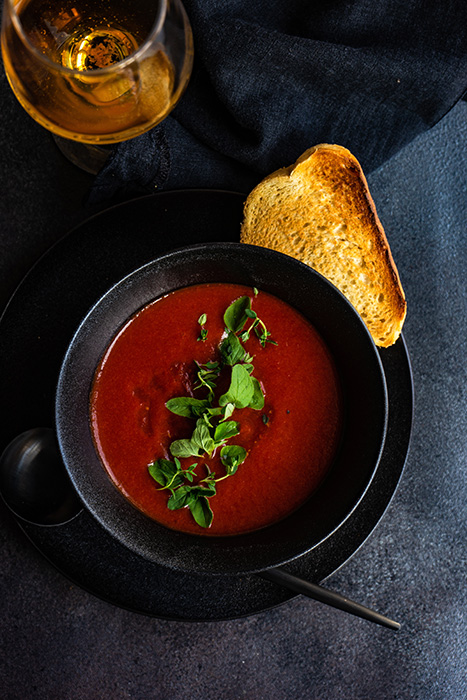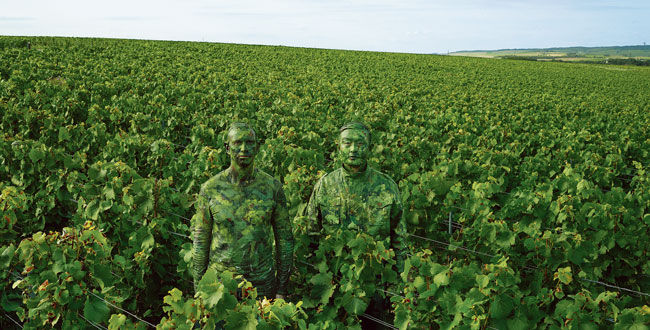
If you’ve been watching the Olympic Games this week (yes, can’t even get away from the subject on your favourite wine blog), you’ll know that it’s become very hot! So those of us at the office have been discussing our summery, no-cook favourite dishes. And the heat of the summer makes a dish like gazpacho particularly welcome at most of our tables. Healthy, refreshing and simple, it ticks all the boxes. Its ingredients make it a bit tricky to pair with wine, but that’s why we’re here…
The original gazpacho is made from mixed tomatoes bulked up with water and combined with garlic, olive oil and salt. This is the base to which can be added ingredients like cucumber, pepper, onions and vinegar. There are also green versions made from Green Zebra tomatoes and yuzu juice, as well as the salmorejo cordobés, a version that differs from the traditional with the addition of breadcrumbs for a creamier consistency. The soup is often topped with pieces of ham and breadcrumbs for added texture.
Whichever version you choose, the tomato, olive oil and garlic provide quite the explosion of flavours…and quite the challenge for wine pairings!
Why is gazpacho with wine destined to fail…in theory?
Tomato, cucumber, olive oil, raw garlic, ham, bread, vinegar…Here’s why these ingredients are particularly difficult to pair:
- Tomato (especially when raw) has a marked acidity that is difficult to balance out with a wine
- Cucumber is very watery
- Garlic (especially raw, as is the case here) is so strong as to overpower the subtleties of a wine
- Olive oil has a marked plant profile
- And vinegar is the sworn enemy of wine with its extreme acidity
We have to admit that, with all this in mind, we won’t find a pairing as magical as dessert wine and blue cheese, oysters and Muscadet or lamb and Médoc. But the adventurous among you might want to have a go at these suggestions…
This is our expert advice
The main things to bear in mind:
- The combined acidity of the tomato and vinegar (and we recommend you add very little of the latter) call for wines with an equal level of acidity.
- The strength of the raw garlic, a very distinct flavour, is better matched with a lively, aromatic and well-structured wine.
These elements push us more towards a white or rosé wine. Forget about reds unless it’s a really light one like a Beaujolais villages or a Poulsard from the Jura. In any case, don’t open a fine red as it’ll be spoilt with this pairing.
If you’re thinking about a rosé, you should choose one with a medium structure, between a fresh and fruity Provençal and a powerful, complex cuvée. Essentially, you don’t want to be opening a bottle from either end of the quality range. Due to its marked flavour, this dish needs a bit of structure, but a fine rosé with delicate aromas would be overpowered. The ideal rosé here is structured with intense aromatics and a fresh hit on the palate. Try a rosé from the Languedoc such as a Pic Saint-Loup, or alternatively try a bottle from Corsica or Tavel.
If you’d prefer a white wine, playing on regional pairings is a good place to start. Spanish wines such as Rioja, Ribeiro, Rueda or Rias Baixas have ripe fruit aromas and a vivacity on the palate that will pair nicely. From France, head for a bottle from Provence, Cassis or Roussillon, as these are powerful wines with good structure and fine aromatics.
In any case, we recommend that you don’t take too much of a risk with this one, so take a look at our crowd-pleasing wine selection for some inspiration.
Our recipe for Andalusian gazpacho
Preparation time: 20 minutes + rest for 24 hours + 10 minutes
Cooking time: 0 minutes
For 6 people
Ingredients
1.5kg ripe tomatoes
300g of slightly dry farmhouse bread
3 red peppers
2 average-sized cucumbers
½ bunch of basil
2 sweet white onions
3 cloves of garlic
150ml extra virgin olive oil
150ml sherry vinegar
salt and pepper to season
Method
Preparing the vegtables
Carefully remove the skin of the tomatoes and then cut them in quarters and remove the seeds.
Peel the peppers and cut them into strips, removing the seeds and the filament inside. You could also burn the pepper skin in the oven in order to remove it but that would take more time and require you turning on the oven – something that we like to avoid in hot weather,
Cut the pepper strips into dices.
Peel the cucumber and dice them.
Remove the basil stalks and chop the leaves into large chunks.
Peel and finely chop the garlic and onion.
Place al the vegetables in a large bowl and mix them with the 150ml of oil.
Season to taste.
Mix well and leave in the fridge for 24 hours.
Preparing the gazpacho the next day
Make breadcrumbs using a mixer and the bread.
Add the vinegar.
Allow the bread to soak up the vinegar.
Add the marinated vegetables and their juice to the bowl and mix well until the mixture is completely smooth.
If you can’t get the mixture smooth, you can pass it through a sieve to get rid of any lumps.
Season with salt and pepper.
Place in the fridge for at least and hour before serving.
Serve the gazpacho in bowls.



